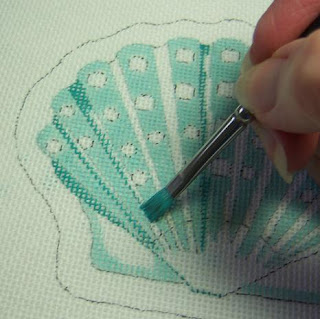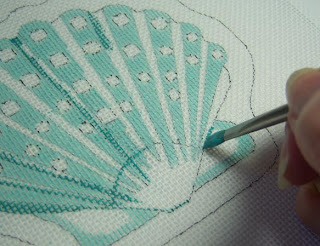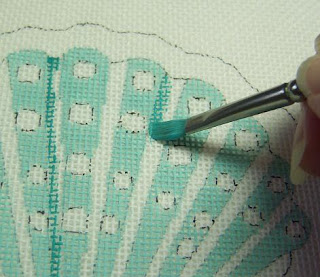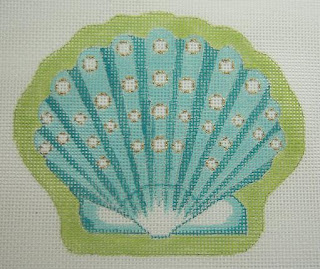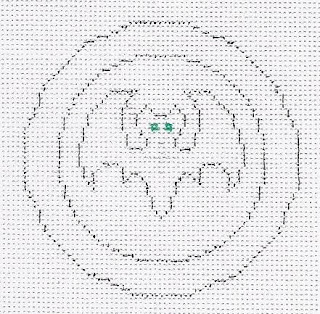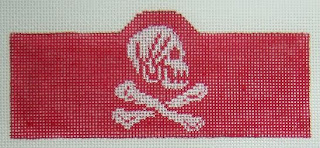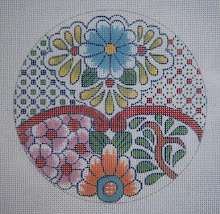 For almost 40 years, I've used almost exclusively the Pilot black drawing pen I mentioned here several times, as there were no colored ones that were safe to use, to my knowledge.
For almost 40 years, I've used almost exclusively the Pilot black drawing pen I mentioned here several times, as there were no colored ones that were safe to use, to my knowledge.
In the past year, I've become acquainted with the Sharpie ultra fine point and fine point permanent pens, and am really enjoying them for certain phases of designing - drawing, not coloring in spaces, as they don't look quite right for it, resembling crude crayon drawings. (I tried it) This has solved a lot of problems for me when putting a design onto canvas either for myself or for wholesale distribution.
Black ink tends to show through the paint, giving the area an unattractive outline, so I usually save the almost worn out ones for making lighter outlines. For something like the Talavera pieces, which have navy outlines around the pattern elements, it doesn't matter, as the paint covers well.
This is a new design, one of four small, ornament size crosses I've put onto canvas this week - and the colored pens have solved several of these problems.
The little ceramic cross, from which I adapted this one, has light green lines just inside the dark lines - so I used the Sharpie drawing pen to draw it in so I wouldn't inadvertantly cover this area with paint when filling in the darker color - then I went back and with paint and a brush and painted over the green line so it would be the correct color. Unfortunately, the color range is very limited in these colored pens - only 24 to 26 colors, and custom mixes aren't possible.
The arrow pointing to the little square at the bottom is only to show where I centered the diaper pattern.
There is a light blue outline around some of the pattern - the red flower at the top - but unfortunately, the DecoColor pens I have recently come to really enjoy, don't come in the right color - This is unfortunate about these wonderful paint pens, as it really would save a lot of time in outlining, etc. Sooooo I had to do as always, and use a brush and paint for the outline.
I painted this Zebra skin mini-stocking today, and it was a big relief to just get out a green DecoColor pen to mark the dots as a guide for the "lace trim" I use here. Before paint pens, I had to, again, use a bottle of paint and a brush - This was much faster, and looks fine. I used the DecoColor fine point for this one, rather than ultra fine.
A word about these pens - I usually try out everything myself to make SURE it is totally safe on needlepoint canvas, but a good friend whose work I admire greatly, told me about them. She has marketed nationally for a number of years, so I trust her judgment. She uses them to actually paint some of her very simple (but wonderful and effective) small canvases, as they cover beautifully, whereas the Sharpie pens don't. I can't use them a lot, as most of my colors have to be mixed. Pity. However, they do solve a lot of problems for me.
There are different pens for different phases of putting a design onto canvas or marking - so it isn't just a matter of choosing an array of pens. One must be sure of what they'll be used for, as they perform differently. An example is here - another of my new designs. I decided to stitch this one, but rarely bother to take the time to paint it for myself. Besides, I enjoy watching it come to life on a white canvas with colored threads.
An example is here - another of my new designs. I decided to stitch this one, but rarely bother to take the time to paint it for myself. Besides, I enjoy watching it come to life on a white canvas with colored threads.
On this one, I intend to use the Kreinik #032 braid, which is a white metallic, and was afraid the black ink might show through - so I used a light blue Sharpie ultra fine point pen to draw this fretwork. Also, it saves the confusion of the line being up against the line of the leaf.
On the painted version, it was just soooo easy to paint the area in solid blue (with brush and paint) and then draw the fretwork on with the WHITE DecoColor pen. (fine point) This works better and faster for this process than paint and brush! Previously, I would have painted the area blue, then drawn the fretwork with the black pen, and painted over it with brush and white paint. An improvement!!!!
Also I was thrilled to find this pen, as it's the only one I've tried that really works well on black canvas for drawing (I use ultra fine for drawing) There is one I tried first that wants to "puddle" now and then - that is, paint dribbles down the point and makes a blob on the canvas. Aggravating!
Incidentally, these pens are also dry-clean proof, which is a consideration especially for larger pieces. Just being waterproof for wet blocking isn't enough. If the ink isn't permanent against dry cleaning fluid, the lines can lift to the top of the work and totally ruin it - I've seen this happen several times, and it's a tragedy.
 Unbelievable that it's already December (in a few hours). I finished this piece last year in October, and, shame on me, I still haven't finished "January."
Unbelievable that it's already December (in a few hours). I finished this piece last year in October, and, shame on me, I still haven't finished "January." 





